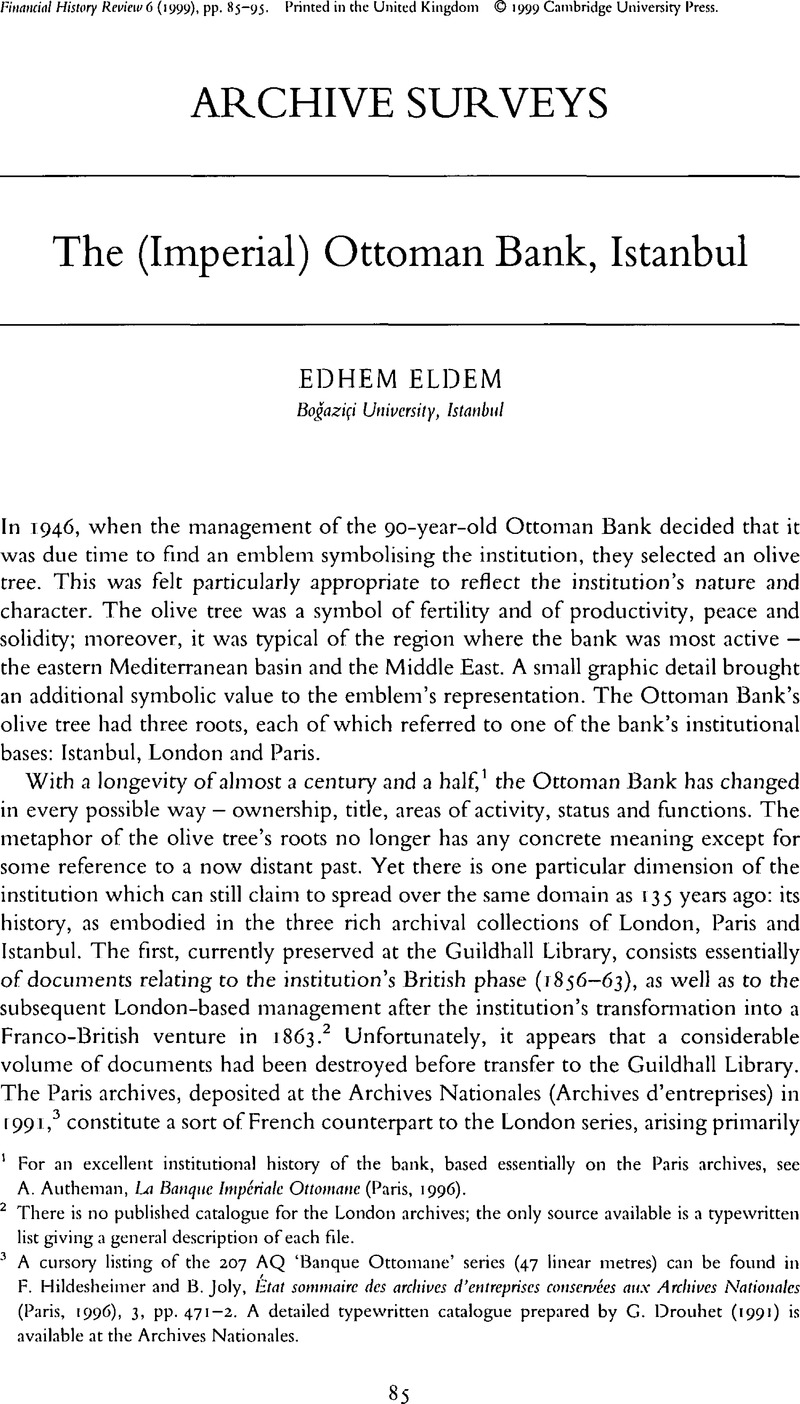Article contents
The (Imperial) Ottoman Bank, Istanbul
Published online by Cambridge University Press: 12 September 2008
Abstract

- Type
- Archive Surveys
- Information
- Copyright
- Copyright © European Association for Banking and Financial History 1999
References
1 For an excellent institutional history of the bank, based essentially on the Paris archives, see Autheman, A., La Banque Impériale Ottomane (Paris, 1996).CrossRefGoogle Scholar
2 There is no published catalogue for the London archives; the only source available is a typewritten list giving a general description of each file.
3 A cursory listing of the 207 AQ ‘Banque Ottomane’ series (47 linear metres) can be found in Hildesheimer, F. and Joly, B., État sommaire des archives d'entreprises conservées aux Archives Nationales (Paris, 1996), 3, pp. 471–2.Google Scholar A detailed typewritten catalogue prepared by G. Drouhet (1991) is available at the Archives Nationales.
4 This is a rough estimation for the sake of illustrating our point and is based upon the simple assumption that every archival ‘unit’ (book, file, register, etc.) represents on average an equivalent volume of documentation.
5 It should be noted that a serious effort is being made to obtain copies of the bank's archives in London and Paris, and that the systematic scanning of the London Committee archives has already started.
6 Eldem, E., Banque Impériale Ottomane. Inventaire commenté des archives (Istanbul, 1994).Google Scholar
7 Eldem, E., A 135-Year-Old Treasure. Glimpses from the Past in the Ottoman Bank Archives (Istanbul, 1998)Google Scholar; idem, Banknotes of the Imperial Ottoman Bank (1863–1914). Based on the Ottoman Bank Archives and the Tahsin Isbiroğlu Collection (Istanbul, 1999).Google Scholar
8 Tarihten Izler. Osmanh Bankast Arşivi Sergisi [Glimpses from the Past. An Exhibition on the Ottoman Bank Archives], inaugurated on 15 December 1997; Nakden Tarih. Osmanh'dan Günümüzc Kağyt Para Sergisi [History in Cash. An exhibition of paper money from Ottoman times to our day], inaugurated on 18 December 1998.
9 Üç Dönem, Bir Banka: Osmanh Bankasi [One Bank for Three Periods of History: The Ottoman Bank], directed by Asaf Köksal, 1998.
10 It should also be noted that, until the 1950s, most of the archival documentation was entirely written in French. Documents in English are much scarcer and are generally found in certain specific series such as the correspondence with the London Committee. As to documents in Turkish, they do appear rather often but almost systematically with a French translation attached.
11 For the sake of simplification, we have grouped under the term ‘unit’ stacks of files or bundles of documents of varying sizes, generally consisting of a substantial number of elements (approximately 20 to 50 files or 200–500 sheets). The term ‘unit’ will also be used for series consisting of a mixture of such units with bound volumes and books.
12 See note 6 above.
13 Two attempts have been made at a systematic analysis of this database – from the viewpoint of some of its cultural choices and from that of its distribution in the urban space of Istanbul at the beginning of the century: Eldem, E., ‘Culture et signature: quelques remarques sur les signatures de clients de la Banque Impériale Ottomane au début du XXe siècle’, Revue du Monde Musulman et de la Méditerranée. Oral et écrit dans le monde turco-ottoman, 75–6 (1995), pp. 181–95Google Scholar, and idem, ‘Istanbul 1903–1918: a quantitative analysis of a bourgeoisie’, Boğaziçt Journal. Review of Social, Economic and Administrative Studies [Istanbul Past and Present Special Issue], 11 (1997), pp. 53–98.Google Scholar
- 2
- Cited by


